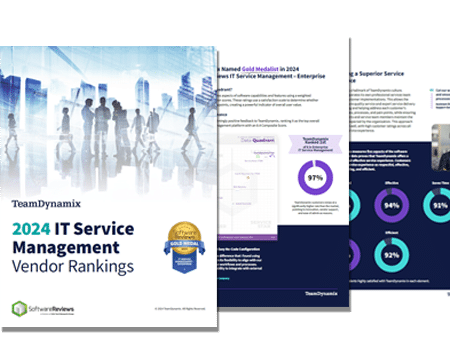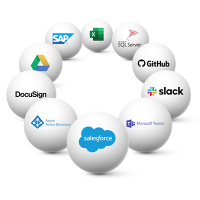
Understanding Change Management and Its Importance Within Your Organization
Did you know that a significant number of IT incidents occur when someone makes a change to one system that then affects other systems in

The Info-Tech ranking report offers a unique view of the market based entirely on in-depth customer interviews. Download the Info-Tech ITSM Quadrant and Customer Viewpoint report today.

We’ll show you some of our best situations and show you exactly how to execute them to get immediate results. The best part is, iPaaS tools often feature easy-to-use click and drag functionality, meaning you don’t need a dedicated employee building integrations and workflows.

System Integrators, Value Added Resellers, Technology Providers, and Buying Consortiums can benefit from a partnership with TeamDynamix.

The Info-Tech ranking report offers a unique view of the market based entirely on in-depth customer interviews. Download the Info-Tech ITSM Quadrant and Customer Viewpoint report to gain a better understanding of key vendor strengths and emerging market requirements.
IT support teams face a number of challenges in today’s world. From dealing with continuous reactionary and repetitive work to big ticket backlogs, staff shortages and trying to use underutilized or insufficient tools to manage the IT help desk – one thing is clear, IT help desks across organizations need help.
A recent study from InformationWeek and TeamDynamix found:
For many organizations, those working the help desk still process those tickets and others like it manually – meaning they are spending hours each day answering the same questions and cleaning up the same tickets when there are tools available that can automate these processes and free up these employees to work on higher priority projects.
For organizations that don’t promote self-service with a well-designed user portal – those IT departments likely spend even more time on these types of tasks.
One of the best ways to solve these challenges is to implement radical automation and integration as part of your IT Service Management (ITSM) strategy.
Low-code/no-code automation and integration tools like iPaaS (integration platform as a service) are a great way to automate and integrate systems across an organization and reduce the toil caused by all of these repetitive tasks, allowing your organization to be more competitive and nimbler with less friction and a better end-user experience.
iPaaS centralizes all integrations into one hub with a library of connectors to common systems such as Workday, Oracle, your IT Service Management (ITSM) platform, Salesforce, the Active Directory, Azure, and hundreds more, as well as any APIs.
With all systems connected and data points now secured in one spot, end-users can leverage the platform to move data, transform data, and build out automation and workflows using a visual flow builder that can be triggered from a field change, form fill or any number of actions.
Some service management tools – like TeamDynamix – offer the ability to combine your service management platform with iPaaS and even a Project Portfolio Management (PPM) tool, all on a single platform. When you do this, you can automate tasks, both simple and complex, as well as connect disparate systems throughout your organization – all through a codeless platform, meaning anyone can use it. You no longer need to be bogged down by repetitive or mundane service requests.
Another benefit of iPaaS is that you don’t need to worry about homegrown scripts or automations – while these might seem like a quick fix to solve the issue of repetitive tasks, they often post a number of security risks and can be difficult to maintain as an organization continues to grow.
In addition, building and maintaining these homegrown integrations and automations can take up even more time – adding to backlogs that can cause project delays and result in unhappy customers.
At Pima County, one of the goals of bringing on TeamDynamix for ITSM and iPaaS (integration platform as a service) is to reduce toil.
“People feel so much more empowered and have so much more worth when they are doing things that are intellectually rigorous and challenging versus when they are just repeating the same mechanical actions over and over and over with very little thought,” Mark Hayes, information technology leader at Pima County, said.
“Our ITSM is our entry point to our entire IT organization, and we want our employees to graduate out of this area into other roles within our organization – network technicians, client services, desktop technicians, developers and project managers,” he continued. “If all they’re doing is handling tickets and doing the same mundane, manual tasks over and over that’s not particularly great training. So investing in tools that allow our employees to engage in meaningful work is something that’s important to us as an overall IT organization.”
With TeamDynamix now in place, Pima County is looking to automate and integrate as much of the manual ITSM processes into workflows as they can.
“The drudgery of working through mundane, repetitive tasks doesn’t exist just in IT,” Hayes said. “I think the more we can reduce toil within the departments that we support, the more people are going to buy in and understand the value of what we’re trying to achieve. There’s nothing like success to breed more success, and once other departments see the benefits they’re going to want these tools too.”
One of the key advantages of TeamDynamix iPaaS is its no-code nature, which empowers technical employees across the organization to set up their own integrations and automations. This democratization of technology reduces the dependency on IT teams, who often face a backlog of requests from various departments.
By enabling non-IT employees to create and manage their own integrations and automations, iPaaS frees up IT staff to focus on higher-level tasks, such as strategic planning and cybersecurity. This not only improves overall efficiency but also fosters a culture of innovation and collaboration within the organization.
“With iPaaS, we’re looking at automating tasks to take some of the things we do manually out of the hands of IT staff, so they can be more efficient,” Barry Bowden, IT Service Desk manager at NaphCare, said.
NaphCare is an Alabama-based company providing healthcare services and software to correctional facilities. They use TeamDynamix for both iPaaS and IT Service Management (ITSM).
Bowden said iPaaS will save him significant time. Currently, setting up and provisioning IT accounts for NaphCare employees is a multi-step process.
NaphCare uses a software program called Adaxes to automate the provisioning of accounts within Active Directory, but IT staff still have to coordinate with both HR staff and the managers of various departments to confirm what IT privileges employees should have—such as whether they should get a free or paid Zoom account. Bowden’s staff includes one full-time employee whose sole responsibility is to perform this work.
With iPaaS in place, NaphCare has created automated workflows for contacting HR and department heads to collect the necessary information. Using iPaaS, Bowden plans to connect TeamDynamix with Adaxes and build a customized workflow to create new user accounts from this information.
Automating this process will enable it to be completed in under five minutes, he says, with very little human intervention needed—freeing up the IT employee responsible for this task to do more strategic work, “That employee can be reallocated to other areas to work on more complex projects,” Bowden said.
There are also plans to automate software provisioning for programs like Microsoft Office.
“It will take me a week, right now, to go in and install Microsoft Office on all the accounts that request it. With automation in place, I won’t need to touch those requests unless there’s a problem. People will be able to go to our portal, put in the request and automatically get the software,” Bowden said. “That’s a full week of time I can get back to work on other things. That will be a huge benefit for us.”
Gainesville Regional Utilities has used TeamDynamix’s integration and automation capabilities to solve a key IT support challenge that affected thousands of retirees.
The software that handles payroll for GRU employees is Workday, which is supported by Gainesville’s IT department along with the other applications used by the city. Retired GRU employees receive their pensions through Workday as well.
However, prior to TeamDynamix, if retirees weren’t getting their pension checks or had trouble with their Workday account, they couldn’t submit a service request using GRU’s online service portal. Because retirees are no longer city employees, they don’t have an Active Directory account, and they need an Active Directory account to submit tickets to IT support staff online.
GRU Business Systems Analyst Tristina Grywalski worked with the TeamDynamix implementation and process consulting teams to develop a simple solution to this problem using the platform’s flexible configuration options.
As a result of their efforts, GRU retirees no longer have to call IT support staff during normal business hours, wasting valuable time for retirees and support staff alike. Instead, they can use the online service portal just like current employees with an Active Directory account can, resulting in faster and better service.
In just the first two months of this capability alone, more than 150 retired GRU employees from all across the country had submitted service requests online. “The service team is very grateful for this solution,” Grywalski said, noting that it has allowed them to be more efficient in resolving people’s problems.
Want to learn more about iPaaS and the positive impact it can have on an organization? Check out the latest market study: InformationWeek: State of IT – Resource Drain.

Did you know that a significant number of IT incidents occur when someone makes a change to one system that then affects other systems in

The construction industry can be very volatile, with a high employee turnover rate due to seasonal fluctuations in the workforce. A key challenge for the

A study from Information Week and TeamDynamix shows companies are looking to invest in IT Service Management (ITSM) software that is simple to administer and
TeamDynamix’s award-winning SaaS cloud solution offers IT Service and Project Management together on one platform with enterprise integration and automation.
[email protected]
(877) 752-6196
Contact Us
